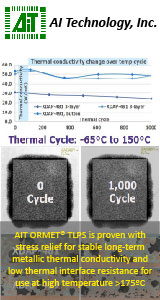|

|
|
| Ask the Experts | |||||||
|
|||||||
|
October 3, 2025 - Updated March 20, 2012 - Originally Posted Reflow Causing WarpWe have a 20 layer PWB that is not balanced, 8 of 10 - 1oz cu layers in the bottom half vs 2 of 10 - 1 oz cu layers in the top. The board bows during reflow. There is a long SMT connector that is mounted to the convex side and the end leads stick up off the board and do not form a solder connection. The board later gets mounted flat into a housing. Currently we are hand soldering the open connector leads after reflow. Other than a better design, what can be done prior to reflow, during reflow, or post reflow, to prevent the board from warping? J.W. |
|||||||
| Expert Panel Responses | |||||||
|
You can take the following precautions.
Capital Equipment Operations Manager Specialty Coating Systems Rodney is currently Operations manager at SCS coatings, Global Leader in Parylene and Liquid Coating equipment. Rodney applies his BS in Computer Integrated Manufacturing from Purdue University, along with 20+ years of Electronic manufacturing and Equipment Assembly, to direct the Equipment business at SCS Coatings. "We provide unique, value added coating equipment solutions for our customers". Including conformal, spin and Parylene coating expertise.
If you are stuck with the design, then the only recourse is to mitigate the warping. If there are mounting holes available in the center of the board, it may be possible to use a fixture to hold the board flatter during reflow. Such a fixture is not a clean solution either. It would most likely have to be applied after printing and placement but prior to reflow. As such there is a risk of knocking components off lands when installing the fixture. You should also be concerned about the residual stresses in solder joints and bending stresses on components with such a design. The SMT connector is soldered to a convex surface, and as the board cools, it flattens again, warping the connector into a concave shape and applying mechanical stress to the joints and leads. You should try to gain an understanding of whether this is a reliability risk.
Process Engineer Astronautics Fritz's career in electronics manufacturing has included diverse engineering roles including PWB fabrication, thick film print & fire, SMT and wave/selective solder process engineering, and electronics materials development and marketing. Fritz's educational background is in mechanical engineering with an emphasis on materials science. Design of Experiments (DoE) techniques have been an area of independent study. Fritz has published over a dozen papers at various industry conferences.
IIT offers titanium board stiffeners that will assist with stabilizing the board during reflow. They easily slide on to the edge of the boards, and will keep the board parallel during reflow. Depending on how imbalanced the inner layers are, the potential remains for warping once the stiffeners are removed after reflow.
Director Integrated Ideas & Technologies, Inc. Stephanie Nash is the Director of Technical Services & Marketing for Integrated Ideas & Technologies, Inc., a premier manufacturer of SMT stencils. She has been instrumental in the stencil design and technical support.
"We have a 20 layer PWB that is not balanced..." That really says it all. Your only recourse will be to restrain the results of this DIM-challenged design with stiffeners. No amount of moisture mitigation, temperature control and weave re-direction will remedy 20 mis-matched layers of thermally induced material tension. If you do use stiffeners I recommend not taking them off until the assemblies truly return to room temperature.
President Circuit Connect, Inc. Bob has been in PCB design and fabrication since 1976. He has held elected positions with the SMTA, is a member of the MSD Council, has served as a committee member for various IPC standards and is a Certified IPC Trainer.
I do not know how practical any of these suggestions are but you could look at a fixture to hold the board flat in the area of the connector. a second approach would be to use a stepped stencil to put additional paste on the end pads (you will need to be careful the you do not get bridging because of the extra metal). Finally you could consider over printing the offending pads (length ways only if space permits) so that when the paste reflows the solder height on the problem pads will be higher and hopefully bridge the gap.
Senior Applications Chemist Henkel Electronics Dr. Poole is a Senior Applications Chemist in Henkel Technologies, electronics assembly materials application engineering group. He is responsible for all of Henkel's assembly products including soldering products, underfills, PCB protection materials, and thermally conductive adhesives.
You must run a thermal profile first to find where the temp differences are on the board. Warp is caused by temperature difference for the most part. This is difficult to solve sometimes because a reflow oven is designed the heat uniformly and your product is not so uniform. If the difference top to bottom, you can use your oven's top vs bottom settings to increase the temp on the cooler surface of the board. If side to side, you could try rotating the board 90 deg so the whole cooler side enters the oven at the same time. If only one smaller portion of the board is cooler, the best thing is to "shield" the hotter portion with a thin layer of insulation material, like PCB material cut to size so the board heats more evenly. In a sense, make up for the design deficiencies by adding or balancing the assembly's heating rate to make it more uniform.
Senior Project Engineer Electronic Controls Design Inc Paul been with Electronic Controls Design Inc. (ECD) in Milwaukie, Oregon for over 39 years as a Senior Project Engineer. He has seen and worked with the electronic manufacturing industry from many points of view, including: technician, engineer, manufacture, and customer. His focus has been the design and application of measurement tools used to improve manufacturing thermal processes and well as moisture sensitive component storage solutions.
Reader Comment
For your warping issue, a mechanical metal stiffener is required prior to the soldering or reflow operation. There is no other way. Large PCBs with heavy components will warp during the soldering or reflow operation. The only way to prevent this is to design in make room and install PCB stiffeners onto the board prior to soldering. Compufab Inc. has provided millions of PCB stiffeners to multi-national electronic companies world wide with great success.
Otto Steiner, Compufab Inc
|
|||||||
| Submit A Comment | |||||||
|
Comments are reviewed prior to posting. You must include your full name to have your comments posted. We will not post your email address. |
|
Free Newsletter Subscription
Circuitnet is built for professionals who bear the responsibility of looking ahead, imagining the future, and preparing for it. Insert Your Email Address |
|

|







